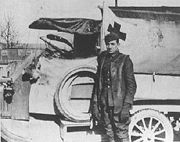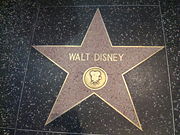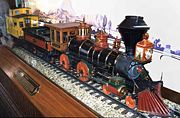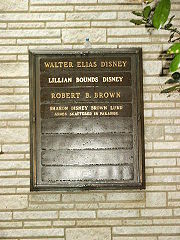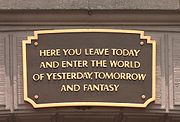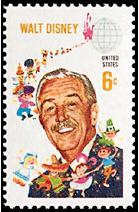Walt Disney
2008/9 Schools Wikipedia Selection. Related subjects: Cartoons; Producers, directors and media figures
| Walt Disney | |||||||||||||||
|---|---|---|---|---|---|---|---|---|---|---|---|---|---|---|---|
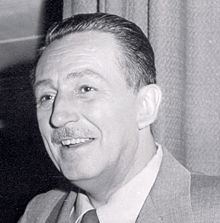 |
|||||||||||||||
| Born | Walter Elias Disney December 5, 1901 Chicago, Illinois |
||||||||||||||
| Died | December 15, 1966 (aged 65) Burbank, California |
||||||||||||||
| Occupation | Film producer, Co-founder of The Walt Disney Company, formerly known as Walt Disney Productions | ||||||||||||||
| Spouse(s) | Lillian Bounds (1925-1966) | ||||||||||||||
|
|||||||||||||||
Walter Elias Disney ( December 5, 1901 – December 15, 1966) was a multiple Academy Award-winning American film producer, director, screenwriter, voice actor, animator, entrepreneur, and philanthropist. Disney is notable as one of the most influential and innovative figures in the field of entertainment during the twentieth century. As the co-founder (with his brother Roy O. Disney) of Walt Disney Productions, Disney became one of the best-known motion picture producers in the world. The corporation he co-founded, now known as The Walt Disney Company, today has annual revenues of approximately U.S. $35 billion.
Disney is particularly noted for being a film producer and a popular showman, as well as an innovator in animation and theme park design. He received fifty-nine Academy Award nominations and won twenty-six Oscars, including a record four in one year. He holds the record for an individual with the most awards and the most nominations. He won seven Emmy Awards. Disney and his staff created a number of the world's most famous fictional characters, including the one many consider Disney's alter ego, Mickey Mouse. He is the namesake for Disneyland and Walt Disney World Resort theme parks in the United States, Japan, France, and China.
Disney died of lung cancer on December 15, 1966, a few years prior to the opening of his Walt Disney World dream project in Lake Buena Vista, Florida.
1901–1937: The beginnings
Childhood
Walt Disney was born to Elias Disney an Irish-Canadian, and his mother, Flora Call Disney, who was of German-American descent. His father moved to the United States from Huron County, Ontario after his parents failed at farming there. In 1906, when Walt was four, Elias along with his family moved to a farm in Marceline, Missouri. While in Marceline, Disney developed his love for drawing. One of their neighbours, a retired doctor named "Doc" Sherwood, paid him to draw pictures of Sherwood's horse, Rupert. He also developed his love for trains in Marceline, which owed its existence to the Atchison, Topeka and Santa Fe Railway which ran through town. Walt would put his ear to the tracks in anticipation of the coming train. Then he would look for his uncle, engineer Michael Martin, running the train.
The Disneys remained in Marceline for four years, before moving to Kansas City in 1911. There, Walt and his sister Ruth attended the Benton Grammar School where he met Walter Pfeiffer. The Pfeiffers were theatre aficionados, and introduced Walt to the world of vaudeville and motion pictures. Soon, Walt was spending more time at the Pfeiffers' than at home.
Teenage years
In 1917, Elias acquired shares in the O-Zell jelly factory in Chicago and moved his family back there. In the fall, Disney began his freshman year at McKinley High School and began taking night courses at the Chicago Art Institute. Disney became the cartoonist for the school newspaper. His cartoons were very patriotic, focusing on World War I. Disney dropped out of high school at the age of sixteen to join the Army, but the army rejected him because he was underage.
After his rejection from the army, Walt and one of his friends decided to join the Red Cross. Soon after he joined the The Red Cross, Walt was sent to France for a year, where he drove an ambulance.
In 1919, Walt, hoping to find work outside the Chicago Ozell factory, left home and moved back to Kansas City to begin his artistic career. His brother Roy worked at a bank in the area and got a job for him, through a friend, at the Pesmen-Rubin Art Studio. At Pesmen-Rubin, Disney created ads for newspapers, magazines, and movie theaters.. It was here that he met a cartoonist named Ubbe Iwwerks. Both of them became close friends and decided to start their own art business;
In January 1920, Disney and Iwerks formed a company called, "Iwerks-Disney Commercial Artists". However, following a rough start, Iwerks left temporarily to earn money at Kansas City Film Ad Company. Disney would soon join Iwwerks at the Kansas City Film Ad Company. While working for the Kansas City Film Ad Company, Disney took up an interest in the field of animation, and decided to become an animator. Walt then decided to open his own animation business, and recruited a fellow co-worker at the Kansas City Film Ad Company, Fred Harman, as his first employee. Walt and Harman then secured a deal with local theatre owner Frank L. Newman-arguably the most popular "showman" in the Kansas City area at the time- to air their cartoons-which they titled Laugh O'Grams- at his local theatre. at his local theatre.
Laugh O'Gram Studios
Presented as "Newman Laugh-O Grams," Disney's cartoons became widely popular in the Kansas City area. Through the success of Laugh-O Grams, Disney was able to acquire his own studio and hire a vast number of additional animators, including Fred Harman's brother Hugh Harman, Rudolph Isling, and Ubbe Iwerks. Unfortunately, with all his employee salaries unable to make up for studio profits, Walt was unable successfully manage money and as a result, the studio would become loaded with debt. The studio would eventually wind up bankrupt; Disney then set his sights on establishing a stuidio the movie industry's capital city Hollywood, California
Hollywood
Together with his brother, Disney pooled in money to set up a cartoon studio in Hollywood Needing to find a distributor for his new Alice Comedies-which he started making while in Kansas City, but never got to distribute- Disney sent an unfinished print to New York distributor Margaret Winkler, who promptly wrote back to him. She was keen on a distribution deal with Disney for more live-action/animated shorts based upon Alice's Wonderland.
Alice Comedies
Virginia Davis (the live-action star of Alice’s Wonderland) and her family were relocated at Disney's request from Kansas City to Hollywood, as were Iwerks and his family. This was the beginning of the Disney Brothers' Studio. It was located on Hyperion Avenue in the Silver Lake district, where the studio would remain until 1939. In 1925, Disney hired a young woman named Lillian Bounds to ink and paint celluloid. After a brief period of dating her, the two got married the same year.
The new series, Alice Comedies, was reasonably successful, and featured both Dawn O'Day and Margie Gay as Alice. Lois Hardwick also briefly assumed the role of Alice. By the time the series ended in 1927, the focus was more on the animated characters, in particular a cat named Julius who resembled Felix the Cat, rather than the live-action Alice.
Oswald the Lucky Rabbit
By 1927, Charles B. Mintz had married Margaret Winkler and assumed control of her business, and ordered a new all-animated series to be put into production for distribution through Universal Pictures. The new series, Oswald the Lucky Rabbit, was an almost instant success, and the character, Oswald—drawn and created by Iwerks—became a popular figure. The Disney studio expanded, and Walt hired back Harman, Ising, Maxwell, and Freleng from Kansas City.
In February 1928, Disney went to New York to negotiate a higher fee per short from Mintz. Disney was shocked when Mintz announced that not only he wanted to reduce the fee he paid Disney per short but also that he had most of his main animators, including Harman, Ising, Maxwell, and Freleng (notably excepting Iwerks) under contract and would start his own studio if Disney did not accept the reduced production budgets. Universal, not Disney, owned the Oswald trademark, and could make the films without Disney. Disney declined Mintz's offer and lost most of his animation staff.
It took Disney's company 78 years to get back the rights to the Oswald character. The Walt Disney Company reacquired the rights to Oswald the Lucky Rabbit from NBC Universal in 2006.
Mickey Mouse
After losing the rights to Oswald, Disney felt the need to develop a new character to replace him. He based the character on a mouse he had adopted as a pet while working in a Kansas City studio. Ub Iwerks reworked on the sketches made by Disney so that it was easier to animate it. However, Mickey's voice and personality was provided by Disney. As many of the old animators have commented, "Ub designed Mickey's physical appearance, but Walt gave him his soul." Besides Oswald and Mickey, a similar mouse-character is seen in Alice Comedies which featured a mouse named Ike the Mouse, and the first Flip the Frog cartoon called Fiddlesticks, which showed a Mickey Mouse-look alike playing fiddle. The initial films were animated by Iwerks, his name was prominently featured on the title cards. The mouse was originally named "Mortimer", but later christened "Mickey Mouse" by Lillian Disney who thought that the name Mortimer did not fit. Mortimer later became the name of Mickey's rival for Minnie, who was taller than his renowned adversary and had a Brooklyn accent.
The first animated short with Mickey in it was titled, Plane Crazy, which was, like all of Disney's previous works, a silent film. After failing to find a distributor for Plane Crazy or its follow-up, The Gallopin' Gaucho, Disney created a Mickey cartoon with sound called Steamboat Willie. A businessman named Pat Powers provided Disney with both distribution and Cinephone, a sound- synchronization process. Steamboat Willie became a success, and Plane Crazy, The Galloping Gaucho, and all future Mickey cartoons were released with soundtracks. Disney himself provided the vocal effects for the earliest cartoons and performed as the voice of Mickey Mouse until 1946. After the release of Steamboat Willie, Walt Disney would continue to successfully use sound in all of his future cartoons; soon, Mickey eclipsed Felix as the world's most popular cartoon. By 1930, Felix, now in sound, had faded from the screen, as his sound cartoons failed to gain attention. Mickey's popularity would now skyrocket in the early 1930s.
Silly Symphonies
Following the footsteps of Mickey Mouse series, a series of musical shorts titled, Silly Symphonies was released in 1929. The first of these was entitled The Skeleton Dance and was entirely drawn and animated by Iwerks, who was also responsible for drawing the majority of cartoons released by Disney in 1928 and 1929. Although both series were successful, the Disney studio was not seeing its rightful share of profits from Pat Powers, and in 1930, Disney signed a new distribution deal with Columbia Pictures. The original basis of the cartoons were musical novelty, and Carl Stalling wrote the score for the first Silly Symphony cartoons as well.
Iwerks was soon lured by Powers into opening his own studio with an exclusive contract. Later, Carl Stalling would also leave Disney to join Iwerks' new studio. Iwerks launched his Flip the Frog series with first voice cartoon in colour, "Fiddlesticks," filmed in two-strip Technicolor. Iwerks also created two other series of cartoons, the Willie Whopper and the Comicolor. In 1936, Iwerks shut his studio to work on various projects dealing with animation technology. He would return to Disney in 1940 and, would go on to pioneer a number of film processes and specialized animation technologies in the studio's research and development department.
By 1932, Mickey Mouse had become quite a popular cinema character, but Silly Symphonies was not as successful. The same year also saw competition for Disney grow worse as Max Fleischer's flapper cartoon character, Betty Boop would gain more popularity among theatre audiences. Fleischer was considered to be Disney's main rival in the 1930s, and was also the father of Richard Fleischer, whom Disney would later hire to direct his 1954 film 20,000 Leagues Under the Sea. Meanwhile, Columbia Pictures dropped the distribution of Disney cartoons and was replaced by United Artists. In late 1932, Herbert Kalmus, who had just completed work on the first three-strip technicolor camera, approached Walt and convinced him to redo Flowers and Trees, which was originally done in black and white, with three-strip Technicolor. Flowers and Trees would go on to be a phenomenal success and would also win the first Academy Award for Best Short Subject: Cartoons for 1932. After Flowers and Trees was released, all future Silly Symphony cartoons were done in colour as well. Disney was also able to negotiate a two-year deal with Technicolor, giving him the sole right to use three-strip Technicolor, which would also eventually be extended to five years as well. Through Silly Symphonies, Disney would also create his most successful cartoon short of all time, The Three Little Pigs, in 1933. The cartoon ran in theaters for many months, and also featured the hit song that became the anthem of the Great Depression, "Who's Afraid of the Big Bad Wolf".
First Academy Award
In 1932, Disney received a special Academy Award for the creation of "Mickey Mouse", whose series was made into colour in 1935 and soon launched spinoff series for supporting characters such as Donald Duck, Goofy, and Pluto; Pluto and Donald would immediately get their individual cartoons in 1937, and Goofy would get solo cartoons in 1939 as well. Of all of Mickey's partners, Donald Duck–who first teamed with Mickey in the 1934 cartoon, Orphan's Benefit–was arguably the most popular, and went on to become Disney's second most successful cartoon character of all time.
Children
Disney's first attempt at pregnancy ended up in Lilly having a miscarriage. When Lilly Disney became pregnant again, she gave birth to a daughter, Diane Marie Disney, on December 18, 1933. A few years later, the Disneys adopted Sharon Mae Disney, (born December 21, 1934) as their second child.
1937–1941: The Golden Age of Animation
"Disney's Folly": Snow White and the Seven Dwarfs
After the creation of two cartoon series, Disney soon began plans for a full-length feature in 1934. In 1935, opinion polls showed that another cartoon series, Popeye the Sailor, produced by Max Fleischer, was more popular than Mickey Mouse. Disney was, however, able to put Mickey back on top, and also increase Mickey's popularity further by colorizing him and partially redesigning him into what was considered to be his most appealing design up to this point in time. When the film industry came to know about Disney's plans to produce an animated feature-length version of Snow White, they dubbed the project as "Disney's Folly" and were certain that the project would destroy the Disney studio. Both Lillian and Roy tried to talk Disney out of the project, but he continued plans for the feature. He employed Chouinard Art Institute professor Don Graham to start a training operation for the studio staff, and used the Silly Symphonies as a platform for experiments in realistic human animation, distinctive character animation, special effects, and the use of specialized processes and apparatus such as the multiplane camera; Disney would first use this new technique in the 1937 Silly Symphonies short The Old Mill.
All of this development and training was used to elevate the quality of the studio so that it would be able to give the feature film, the quality Disney desired. Snow White and the Seven Dwarfs, as the feature was named, was in full production from 1934 until mid-1937, when the studio ran out of money. To acquire the funding to complete Snow White, Disney had to show a rough cut of the motion picture to loan officers at the Bank of America, who gave the studio the money to finish the picture. The finished film premiered at the Carthay Circle Theatre on December 21, 1937; at the conclusion of the film, the audience gave Snow White and the Seven Dwarfs a standing ovation. Snow White, the first animated feature in English and Technicolor, was released in February 1938 under a new distribution deal with RKO Radio Pictures; RKO had previously been the distributor for Disney cartoons in 1936, after it closed down the Van Beuren Studios in exchange for distribution. The film became the most successful motion picture of 1938 and earned over $8 million in its original theatrical release. The success of Snow White, (for which Disney received one full-size, and seven miniature Oscar statuettes) allowed Disney to build a new campus for the Walt Disney Studios in Burbank, which opened for business on December 24, 1939; Snow White was not only the peak of Disney's success, but it also ushered into what was known as the Golden Age of Animation for Disney. The feature animation staff, having just completed Pinocchio, continued work on Fantasia and Bambi, while the shorts staff continued work on the Mickey Mouse, Donald Duck, Goofy, and Pluto cartoon series, ending the Silly Symphonies at this time. Animator Fred Moore had redesigned Mickey Mouse in the late 1930s, when Donald Duck began to gain more popularity among theatre audiences than Mickey Mouse.
During World War II
Pinocchio and Fantasia followed Snow White and the Seven Dwarfs into the movie theaters in 1940, but both were financial disappointments. The inexpensive Dumbo was planned as an income generator, but during production of the new film, most of the animation staff went on strike, permanently straining the relationship between Disney and his artists.
Shortly after the release of Dumbo in October 1941, the United States entered World War II. The U.S. Army contracted most of the Disney studio's facilities and had the staff create training and instructional films for the military, home-front morale-boosting shorts such as Der Fuehrer's Face and the feature film Victory Through Air Power in 1943. However, the military films did not generate income, and the feature film Bambi underperformed when it was released in April 1942. Disney successfully re-issued Snow White in 1944, establishing a 7-year re-release tradition for Disney features.
The Disney studios also created inexpensive package films, containing collections of cartoon shorts, and issued them to theaters during this period. The most notable and successful of these were Saludos Amigos (1942), its sequel The Three Caballeros (1945), Fun and Fancy Free (1947), and The Adventures of Ichabod and Mr. Toad (1949). The latter had only two sections: the first based on The Legend of Sleepy Hollow by Washington Irving, and the second based on The Wind in the Willows by Kenneth Grahame. During this period, Disney also ventured into full-length dramatic films that mixed live action and animated scenes, including Song of the South and So Dear to My Heart. After the war ended, Mickey's popularity would also fade as well.
By the late 1940s, the studio had recovered enough to continue production on the full-length features, Alice in Wonderland and Peter Pan, which had been shelved during the war years, and began work on Cinderella, which became Disney's most successful film since Snow White and the Seven Dwarfs. The studio also began a series of live-action nature films, entitled True-Life Adventures, in 1948 with On Seal Island. Despite rebounding success through feature films, Disney's animation shorts were no longer as popular as they used to be, and people began to instead draw attention to Warner Bros and their animation star Bugs Bunny; by 1942, Warner Bros' Termite Terrace officially became the most popular animation studio. However, while Bugs Bunny's popularity rose in the 1940s, so did Donald Duck's; Donald would also replace Mickey Mouse as Disney's star character in 1949.
Testimony before Congress
In 1947, during the early years of the Cold War, Disney testified before the House Un-American Activities Committee, where he branded Herbert Sorrell, David Hilberman and William Pomerance, former animators and labor union organizers, as Communist agitators. All three men denied the allegations. Disney implicated the Screen Actors Guild as a Communist front, and charged that the 1941 strike was part of an organized Communist effort to gain influence in Hollywood. However, no evidence has been discovered to support this.
1955–1966: Theme parks and beyond
Carolwood Pacific Railroad
During 1949, Disney and his family moved to a new home on a large piece of property in the Holmby Hills district of Los Angeles, California. With the help of his friends Ward and Betty Kimball, owners of their own backyard railroad, Disney developed blueprints and immediately set to work on creating a miniature live steam railroad for his backyard. The name of the railroad, Carolwood Pacific Railroad, originated from the address of his home that was located on Carolwood Drive. The railroad's half-mile long layout included a 46-foot (14 m)-long trestle, loops, overpasses, gradients, an elevated dirt berm, and a 90-foot (27 m) tunnel underneath Mrs. Disney's flowerbed. He named the miniature working steam locomotive built by Roger E. Broggie of the Disney Studios Lilly Belle in his wife's honour. He had his attorney draw up right-of-way papers giving the railroad a permanent, legal easement through the garden areas, which his wife dutifully signed; However, there is no evidence of the documents ever recorded as a restriction on the property's title.
Planning Disneyland
On a business trip to Chicago in the late-1940s, Disney drew sketches of his ideas for an amusement park where he envisioned his employees spending time with their children. He got his idea for a children's theme park after visiting Children's Fairyland in Oakland, California. This plan was originally meant for a plot located south of the Studio, across the street. The original ideas developed into a concept for a larger enterprise that was to become Disneyland. Disney spent five years of his life developing Disneyland and created a new subsidiary of his company, called WED Enterprises, to carry out the planning and production of the park. A small group of Disney studio employees joined the Disneyland development project as engineers and planners, and were dubbed Imagineers.
When describing one of his earliest plans to Herb Ryman (who created the first aerial drawing of Disneyland which was presented to the Bank of America while requesting for funds), Disney said, "Herbie, I just want it to look like nothing else in the world. And it should be surrounded by a train." Entertaining his daughters and their friends in his backyard and taking them for rides on his Carolwood Pacific Railroad had inspired Disney to include a railroad in the plans for Disneyland.
Expanding into new areas
As Walt Disney Productions began work on Disneyland, it also began expanding its other entertainment operations. In 1950, Treasure Island became the studio's first all-live-action feature, and was soon followed by 20,000 Leagues Under the Sea (in CinemaScope, 1954), The Shaggy Dog (1959), and The Parent Trap (1961). The Walt Disney Studio produced its first TV special, One Hour in Wonderland, in 1950. Disney began hosting a weekly anthology series on ABC named Disneyland after the park, where he showed clips of past Disney productions, gave tours of his studio, and familiarized the public with Disneyland as it was being constructed in Anaheim, California. The show also featured a Davy Crockett miniseries, which started a craze among the American youth known as the Davy Crockett craze, in which millions of coonskin caps and other Crockett memorabilia were sold across the country. In 1955, the studio's first daily television show, Mickey Mouse Club debuted, which would continue in many various incarnations into the 1990s.
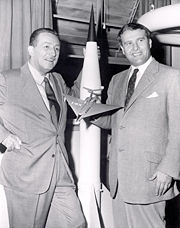
As the studio expanded and diversified into other media, Disney devoted less of his attention to the animation department, entrusting most of its operations to his key animators, whom he dubbed the Nine Old Men. During Disney's lifetime, the animation department created the successful Lady and the Tramp (in CinemaScope, 1955), One Hundred and One Dalmatians (1961), Sleeping Beauty (in Super Technirama 70mm, 1959) and The Sword in the Stone (1963).
Production on the short cartoons had kept pace until 1956, when Disney shut down the shorts division. Special shorts projects would continue to be made for the rest of the studio's duration on an irregular basis. These productions were all distributed by Disney's new subsidiary, Buena Vista Distribution, which had assumed all distribution duties for Disney films from RKO by 1955. Disneyland, one of the world's first theme parks, finally opened on July 17, 1955, and was immediately successful. Visitors from around the world came to visit Disneyland, which contained attractions based upon a number of successful Disney properties and films. After 1955, the show, Disneyland came to be known as Walt Disney Presents. The show transformed from black-and-white to colour in 1961 and changed its name to Walt Disney's Wonderful World of Colour, moving from ABC to NBC, and eventually evolving into its current form as The Wonderful World of Disney. It continued to air on NBC until 1981, when CBS picked it up. Since then, it has aired on ABC, NBC, Hallmark Channel and Cartoon Network via separate broadcast rights deals.
During the mid-1950s, Disney produced a number of educational films on the space program in collaboration with NASA rocket designer Wernher von Braun: Man in Space and Man and the Moon in 1955, and Mars and Beyond in 1957.
Early 1960s successes
By the early 1960s, the Disney empire was a major success, and Walt Disney Productions had established itself as the world's leading producer of family entertainment. Walt Disney was the Head of Pageantry for the 1960 Winter Olympics. After decades of pursuing, Disney finally procured the rights to P.L. Travers' books about a magical nanny. Mary Poppins, released in 1964, was the most successful Disney film of the 1960s and featured a memorable song score written by Disney favorites, the Sherman Brothers. The same year, Disney debuted a number of exhibits at the 1964 New York World's Fair, including Audio- Animatronic figures, all of which were later integrated into attractions at Disneyland and a new theme park project which was to be established on the East Coast.
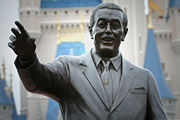
Plans for Disney World and EPCOT
Disney World was to include a larger, more elaborate version of Disneyland which was to be called the Magic Kingdom. It would also feature a number of golf courses and resort hotels. The heart of Disney World, however, was to be the Experimental Prototype City (or Community) of Tomorrow, or EPCOT for short. EPCOT was designed to be an operational city where residents would live, work, and interact using advanced and experimental technology, while scientists would develop and test new technologies to improve human life and health.
Death
Disney's involvement in Disney World ended in late 1966; after many years of chain smoking cigarettes, he was diagnosed with lung cancer. He was admitted to Providence St. Joseph Medical Centre across the street from the Disney Studio, where his health began to deteriorate, causing him to suffer cardiac arrest. Just before he was hospitalized, Disney was scheduled to undergo a neck surgery for an old polo injury; Disney was a frequent polo player at The Riveria Club in Hollywood, California for many years. On November 2, 1966, during pre-surgery X-rays, doctors at St. Joseph's Hospital in Los Angeles discovered that Disney had an enormous tumor on his left lung. Five days later, Disney went back to hospital for surgery, but the tumor had spread to such great extent that doctors had to remove his entire left lung. The doctors then told Disney that he only had six months to a year to live. After several chemotherapy sessions, Disney and his wife spent a short amount of time in Palm Springs, California before returning home. On November 30, 1966, Disney collapsed in his home, but was revived by paramedics, and was taken back to the hospital, where he died on December 15, 1966 at 9:30 a.m., ten days after his sixty-fifth birthday. He was cremated on December 17, 1966 and his ashes reside at the Forest Lawn Memorial Park in Glendale, California. Roy O. Disney continued to carry out the Florida project, insisting that the name be changed to Walt Disney World in honour of his brother.
Songwriter Robert B. Sherman said about the last time he saw Disney:
| “ | He was up in the third floor of the animation building after a run-through of The Happiest Millionaire. He usually held court in the hallway afterward for the people involved with the picture. And he started talking to them, telling them what he liked and what they should change, and then, when they were through, he turned to us and with a big smile, he said, 'Keep up the good work, boys.' And he walked to his office. It was the last we ever saw of him. | ” |
Shortly after the death of Walt Disney, satirist Paul Krassner published The Disneyland Memorial Orgy, a cartoon illustration portraying the liberated behaviour of the Disney characters. A long-standing urban legend maintains that Disney was cryonically frozen, and his frozen corpse was stored underneath the Pirates of the Caribbean ride at Disneyland. However, this was discredited due to the fact that Disney was cremated, and the first known instance of Cryonic Freezing of a corpse (of Dr. James Bedford) occurred a month later in January.
The final productions in which Disney had an active role were the animated feature, The Jungle Book and the live-action musical comedy The Happiest Millionaire, both released in 1967.
1967–present: Legacy
Continuing the vision
After Walt Disney's death, Roy Disney returned from retirement to take full control of Walt Disney Productions and WED Enterprises. In October that year, their families met in front of Cinderella Castle at the Magic Kingdom to officially open the Walt Disney World Resort.
After giving his dedication for Walt Disney World, he then asked Lillian Disney to join him. As the orchestra played " When You Wish Upon a Star", she stepped up to the podium accompanied by Mickey Mouse. He then said, "Lilly, you knew all of Walt's ideas and hopes as well as anybody; what would Walt think of it [Walt Disney World]?". "I think Walt would have approved," she replied. Roy died from a cerebral hemorrhage on December 20, 1971, the day he was due to open the Disneyland Christmas parade.
During the second phase of the "Walt Disney World" theme park, EPCOT was translated by Disney's successors into EPCOT Centre, which opened in 1982. As it currently exists, EPCOT is essentially a living world's fair, different from the actual functional city that Disney had envisioned. In 1992, Walt Disney Imagineering took the step closer to Walt's vision and dedicated Celebration, Florida, a town built by the Walt Disney Company adjacent to Walt Disney World, that hearkens back to the spirit of EPCOT. EPCOT was also originally intended to be devoid of Disney characters which initially limited the appeal of the park to young children but the company later changed this policy.
The Disney entertainment empire
Today, Walt Disney's animation/motion picture studios and theme parks have developed into a multi-billion dollar television, motion picture, vacation destination and media corporation that carry his name. The Walt Disney Company today owns, among other assets, five vacation resorts, eleven theme parks, two water parks, thirty-nine hotels, eight motion picture studios, six record labels, eleven cable television networks, and one terrestrial television network. As of 2007, the company has an annual revenue of over U.S. $35 billion.
Disney Animation today
Traditional hand-drawn animation, with which Walt Disney started his company, no longer continues at the Walt Disney Feature Animation studio. After a stream of financially unsuccessful traditionally-animated features in the late-1990s and early 2000s, the two satellite studios in Paris and Orlando were closed, and the main studio in Burbank was converted to a computer animation production facility. In 2004, Disney released what was announced as their final "traditionally animated" feature film, Home on the Range. However, since the 2006 acquisition of Pixar and the resulting rise of John Lasseter to Chief Creative Officer, that position has changed, and the upcoming 2009 film The Princess and the Frog will mark Disney's return to traditional 2-D animation.
CalArts
In his later years, Disney devoted substantial time towards funding The California Institute of the Arts (CalArts). It was formed in 1961 through a merger of the Los Angeles Conservatory of Music and the Chouinard Art Institute, which had helped in the training of the animation staff during the 1930s. When Disney died, one-fourth of his estate went towards CalArts, which helped in building its campus. In his will, Disney paved the way for creation of several charitable trusts which included one for the California Institute of the Arts and other for the Disney Foundation. He also donated 38 acres ( Template:Convert/sqmi km²) of the Golden Oaks ranch in Valencia for the school to be built on. CalArts moved onto the Valencia campus in 1971.
In an early admissions bulletin, Disney explained:
| “ | A hundred years ago, Wagner conceived of a perfect and all-embracing art, combining music, drama, painting, and the dance, but in his wildest imagination he had no hint what infinite possibilities were to become commonplace through the invention of recording, radio, cinema and television. There already have been geniuses combining the arts in the mass-communications media, and they have already given us powerful new art forms. The future holds bright promise for those who imaginations are trained to play on the vast orchestra of the art-in-combination. Such supermen will appear most certainly in those environments which provide contact with all the arts, but even those who devote themselves to a single phase of art will benefit from broadened horizons. | ” |
Academy Awards
Walt Disney holds the records for number of Academy Award nominations (with fifty-nine) and number of awarded Oscars (twenty-six, below). Four of his Oscars were special awards, and one, his last, was granted posthumously.
- 1932: Best Short Subject, Cartoons for: Flowers and Trees (1932)
- 1932: Honorary Award for: creation of Mickey Mouse.
- 1934: Best Short Subject, Cartoons for: Three Little Pigs (1933)
- 1935: Best Short Subject, Cartoons for: The Tortoise and the Hare (1934)
- 1936: Best Short Subject, Cartoons for: Three Orphan Kittens (1935)
- 1937: Best Short Subject, Cartoons for: The Country Cousin (1936)
- 1938: Best Short Subject, Cartoons for: The Old Mill (1937)
- 1939: Best Short Subject, Cartoons for: Ferdinand the Bull (1938)
- 1938: Honorary Award for Snow White and the Seven Dwarfs (1938) The citation read: "For Snow White and the Seven Dwarfs, recognized as a significant screen innovation which has charmed millions and pioneered a great new entertainment field" (the award was one statuette and seven miniature statuettes)
- 1940: Best Short Subject, Cartoons for: Ugly Duckling(1939)
- 1941: Honorary Award for: Fantasia (1941), shared with: William E. Garity and J.N.A. Hawkins. The citation for the certificate of merit read: "For their outstanding contribution to the advancement of the use of sound in motion pictures through the production of Fantasia"
- 1942: Best Short Subject, Cartoons for: Lend a Paw (1941)
- 1943: Best Short Subject, Cartoons for: Der Fuehrer's Face (1942)
- 1949: Best Short Subject, Two-reel for: Seal Island (1948)
- 1949: Irving G. Thalberg Memorial Award
- 1951: Best Short Subject, Two-reel for: Beaver Valley (1950)
- 1952: Best Short Subject, Two-reel for: Nature's Half Acre (1951)
- 1953: Best Short Subject, Two-reel for: Water Birds (1952)
- 1954: Best Documentary, Features for: The Living Desert (1953)
- 1954: Best Documentary, Short Subjects for: The Alaskan Eskimo (1953)
- 1954: Best Short Subject, Cartoons for: Toot Whistle Plunk and Boom (1953)
- 1954: Best Short Subject, Two-reel for: Bear Country (1953)
- 1955: Best Documentary, Features for: The Vanishing Prairie (1954)
- 1956: Best Documentary, Short Subjects for: Men Against the Arctic
- 1959: Best Short Subject, Live Action Subjects for: Grand Canyon
- 1969: Best Short Subject, Cartoons for: Winnie the Pooh and the Blustery Day
Other honours
Walt Disney was the inaugural recipient of a star on the Anaheim walk of stars. The star was awarded in honour of Disney's significant contributions to the city of Anaheim, California, specifically, Disneyland, which is now the Disneyland Resort. The star is located at the pedestrian entrance to the Disneyland Resort on Harbour Boulevard.
Walt Disney received the Congressional Gold Medal on 24 May 1968 (P.L. 90-316, 82 Stat. 130-131) and the Légion d'Honneur in France in 1935. In 1935, Walt received a special medal from the League of Nations for creation of Mickey Mouse. He also received the Presidential Medal of Freedom on 14 September 1964. On 6 December 2006, California Governor Arnold Schwarzenegger and First Lady Maria Shriver inducted Walt Disney into the California Hall of Fame located at The California Museum for History, Women, and the Arts.
A minor planet 4017 Disneya discovered in 1980 by Soviet astronomer Lyudmila Georgievna Karachkina is named after him.
